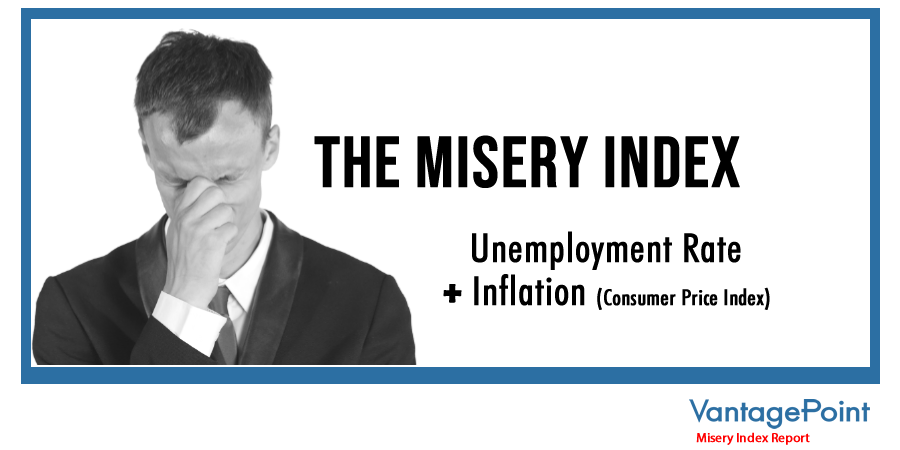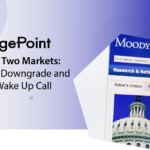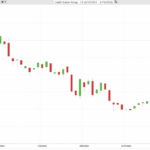How the Misery Index Could Move Your Portfolio: Inflation, Unemployment, and Market Impacts
Inflation’s grip on everyday life has sharpened attention on a long-standing gauge of economic discomfort known as the Misery Index. This article takes a deep, structured look at what the Misery Index measures, how it’s calculated, and why it matters for voters, policymakers, and traders alike. It examines historical moments when the index moved the political tide, then turns to how present conditions—marked by rising unemployment and accelerating prices—shape investment thinking. Finally, it explores how modern traders use data-driven tools, including artificial intelligence, to interpret the Misery Index within the broader landscape of risk and opportunity.
Foundations of the Misery Index: Calculation, Core Inputs, and Variations
The Misery Index is rooted in a straightforward idea: the more economic distress ordinary citizens feel, the lower their confidence in the current government and the more likely political outcomes will shift. The original, simplest formula adds two core inputs: the inflation rate and the unemployment rate. When either input rises, the Index climbs; when both move in opposite directions or retreat together, the Index eases. The beauty of this construction lies in its transparency: a single composite number translates complex macro dynamics into an easily understood “happiness quotient” for a country’s economy. In everyday terms, the Misery Index provides a snapshot of the consumer experience by combining macro variables that directly affect living standards—what people pay for goods and services and whether they can find work.
Over time, economists and scholars have proposed modest refinements to the index to add nuance without sacrificing the simplicity that makes it instantly graspable. A common enhancement adds a few additional inputs that, in theory, capture broader financial conditions and the momentum of the economy. For example, analysts have experimented with including the lending rate set by banks and the growth rate of real GDP. The augmented formula can be written as: Misery Index equals Unemployment plus Inflation plus Bank Lending Rate, minus Real GDP Growth. Even with these refinements, the core message remains: when the Misery Index rises, economic unhappiness tends to be higher, and when it falls, the mood lightens. The index thus functions as a quick barometer of the overall consumer experience in the marketplace, highlighting not just price changes and job availability, but the broader context in which households allocate resources and make decisions.
In political analysis, the Misery Index has a well-worn role in elevating debate during election cycles. When the index increases, it often correlates with rising disapproval of the incumbent administration, and political commentators frequently invoke the metric to frame expected outcomes. The logic is intuitive: high inflation erodes purchasing power, rising unemployment strains household budgets, and together they can undermine public support for the party in power. Conversely, a declining Misery Index can bolster political support as households feel relief through steadier prices and more job security. The historical anecdotes are telling: in one presidential cycle, a candidate leveraged a moderately elevated Misery Index to victory by promising relief and policy change; in another cycle, a higher reading did not prevent a political upset because other factors—such as optimism about anticipated reforms or external economic forces—also influenced voters.
To understand the Misery Index more deeply, consider the macroeconomic lens through which it is viewed. Economists interpret the index as a high-level indicator of consumer welfare and the balance of demand and supply pressures in the economy. A rising index often accompanies inflationary episodes where prices surge while job growth fails to keep pace, creating a squeeze on household budgets. A falling index typically signals a cooling of price pressures, improved labor markets, or both. The index thus serves as a concise barometer of the broader health of the economy, offering policymakers, investors, and the public a way to assess, at a glance, whether the path ahead is likely to be smoother or rockier.
The Misery Index is not a perfect predictor, and its simplicity invites scrutiny. Critics point out that inflation and unemployment do not capture all dimensions of economic well-being, such as wage growth, income distribution, healthcare costs, housing affordability, and the risk of financial shocks. Some argue that the index can mask structural changes, such as shifts in labor force participation or productivity, that influence long-run prosperity even when the short-run inflation and unemployment numbers look favorable. Yet proponents maintain that the index remains a practical, easily communicable tool for framing the mood of an economy, and a starting point for deeper analysis rather than a definitive measure of welfare.
Historical illustrations reinforce the index’s staying power, even as its components and interpretations evolve. The instance of the late 1970s and early 1980s—when inflation ran high and unemployment fluctuated, creating a period often described as stagflation—demonstrates how the Misery Index can reflect simultaneous pressures on prices and jobs. While these conditions tested policymakers and markets, the index helped paint a clear picture of the consumer environment that voters and investors were navigating. In that sense, the Misery Index acts as a classroom for understanding how macro forces interact and how those interactions translate into real-world outcomes, particularly in the realms of politics and capital markets.
In practice, practitioners who track the Misery Index often compare its movements to other benchmarks, such as wage growth, labor force participation, consumer sentiment, and credit conditions. They monitor whether the purchasing power of households is eroding even as job opportunities expand, or whether real incomes are improving as inflation moderates and employment strengthens. The index then becomes part of a broader narrative about the state of the business cycle, the pace of monetary policy, and the prospects for economic resilience. When paired with trend analysis and scenario planning, the Misery Index can help stakeholders gauge whether policy actions—such as fiscal stimulus, tax policy changes, or monetary adjustments—are likely to ease or prolong the pain felt by households.
In summary, the Misery Index remains a deceptively simple yet enduringly useful metric. Its core input—inflation plus unemployment—provides an at-a-glance view of consumer hardship, while its extended formulations incorporate additional financial conditions to refine insight. The metric’s public-facing appeal lies in its clarity: a single number that communicates a country’s economic discomfort to audiences across professions and backgrounds. As with any macroeconomic tool, its strength comes from understanding its limits, keeping it in dialogue with a broader array of indicators, and using it as a guide for deeper investigation into the forces shaping living standards and political sentiment.
The historical anchor: presidential cycles and the Misery Index
From a political economy perspective, the Misery Index has become a lens through which election dynamics are interpreted. When the metric reveals elevated hardship ahead of an election, analysts often anticipate heightened scrutiny of incumbents and a potential shift in governance. The historical record includes notable episodes where the index’s readings intersected with electoral outcomes, prompting scholars and pundits to draw connections between macro shocks and voting behavior. While correlation does not imply causation, the pattern remains instructive: economic conditions that depress household welfare can amplify calls for change, especially in leader-driven systems where incumbents are held accountable for the lived experience of citizens.
The Misery Index’s enduring appeal also lies in its interpretive simplicity. A journalist or analyst can describe an upswing in the index as a signal of rising economic pain, or a decline as a sigh of relief, without requiring the public to sift through a matrix of data. That accessibility makes the Misery Index a useful reference in media coverage of policy debates, budget negotiations, and political campaigns. It offers a shared language that translates disparate data points into a narrative about how ordinary people are faring, which in turn informs public discourse about the intentions and effectiveness of policymakers.
In practical terms, the Misery Index functions best as a diagnostic yardstick rather than a prescription. It identifies the presence and magnitude of adversity, prompting further examination of the underlying drivers—whether they are supply-side constraints, demand-side overheating, structural unemployment, or policy misalignment. For investors and traders, the index’s readings invite consideration of how inflation expectations, wage dynamics, and monetary responses might evolve in tandem with political risk. Taken together, these dimensions illustrate why the Misery Index has remained a central reference point for those seeking to understand the relationship between macroeconomic health, governance, and market expectations.
A practical look at the late 20th and early 21st centuries
Historically, the Misery Index has shown that the relationship between macro pressures and asset markets can be nuanced. In certain episodes, higher readings corresponded with periods of heightened volatility and a search for safer assets, while in others, asset prices rose despite pain on Main Street as inflation fed the value of financial assets. This counterintuitive pattern underscores a core insight for analysts: asset prices do not move solely in response to the misery level; they respond to the expectations about future policy, inflation, growth, and liquidity. The nuance matters for traders who search for signals that are robust across varied macro regimes and for policymakers seeking to balance price stability with employment and growth.
For researchers and practitioners, the Misery Index provides a starting point for analyzing the interaction between policy choices and outcomes. It invites questions about how monetary policy, fiscal stimulus, and labor-market interventions shape the trajectory of inflation and unemployment, and, by extension, the direction of markets. While the index does not answer these questions by itself, it helps frame the stakes and highlight when tensions between price pressures and job security are likely to intensify. In this way, the Misery Index acts as a catalyst for deeper inquiry into how economies absorb shocks, adapt to new realities, and produce outcomes that matter to citizens and investors alike.
As a practical matter for readers and practitioners, the miseries highlighted by the index remain a call to scrutinize the broader structural factors at play. Price dynamics can reflect cyclical demand, supply chain frictions, productivity shifts, and policy expectations—all of which interact to determine the real purchasing power of households. By keeping the Misery Index in view, analysts can maintain a holistic view of the economic environment, balancing the immediacy of monthly data with longer-run trends that shape consumer behavior and risk appetite in financial markets.
Global readings and historical context: from 2020 to today, and the lessons they offer
The Misery Index does not confine itself to a single nation’s borders; its logic translates across economies, revealing the severity of distress in places where inflation burns through purchasing power while unemployment remains stubbornly high. In 2020, amid a global health crisis that disrupted labor markets and supply chains, several economies faced extraordinary pain. For instance, some countries recorded Misery Index figures in the thousands of percent, underscoring how far price changes and unemployment could diverge in extreme conditions. These extreme readings illustrate the extremities that macro shocks can produce, even as developing and commodity-led economies may experience a sharper break from historical norms. The lessons from those years emphasize that the level of economic discomfort is not uniform; it can spike dramatically in contexts of abrupt demand collapse, sudden supply limitations, or currency pressures, while other economies with stronger policy responses and broader fiscal support may experience more tempered trajectories.
In the United States, the national Misery Index has moved through its own cycle of stress and relief, with readings that reflect the interplay of health crises, policy measures, and labor-market dynamics. After a period of lockdowns and abrupt changes in consumer behavior, the index briefly spiked as unemployment rose under the weight of shutdowns, then moderated as job markets recovered and inflation trends evolved. The current reading—while still subject to revision and influenced by evolving policy and external factors—indicates a complex balance: unemployment remains elevated relative to pre-crisis levels, while inflation has persisted at levels that affect real incomes and the spending power of households. This duality—joblessness coupled with price pressures—echoes the stagflationary patterns that defined earlier decades, though the structural drivers today may differ, with technology, globalization, and policy responses shaping the outcomes in distinct ways.
Cross-border comparisons reveal a spectrum of experiences. Some economies registered extraordinarily high Misery Index figures in 2020 and the subsequent years, with inflation surging while unemployment climbed for a time due to health restrictions, supply disruptions, and structural constraints. Other countries managed to stabilize prices more effectively, even as labor market challenges persisted, underscoring the importance of policy design and domestic resilience in shaping outcomes. The global dispersion of Misery Index readings has practical implications for investors seeking international diversification, multinational corporations evaluating exposure to different macro regimes, and policymakers aiming to calibrate stabilization tools to minimize the social and economic costs of price and job dislocations.
From a macro perspective, the Misery Index helps illuminate the path of the global economy through episodes of upheaval and recovery. It captures the moment when households face the combined burden of rising costs and uncertain employment prospects, but it also signals the point at which policy measures and market mechanisms begin to stabilize conditions. The index thus serves as both a diagnostic instrument and a forecasting lens—indicating when risk to consumer welfare is most pronounced and when the trajectory of inflation, unemployment, and growth may converge toward more favorable outcomes. For traders and investors, these moments offer opportunities to reallocate resources in anticipation of policy shifts, the normalization of inflation, and the eventual restoration of purchasing power for households.
Global case studies underscore two enduring themes for interpretation. First, the Misery Index is most informative when viewed as part of a broader framework that includes wage trends, household debt, credit availability, and the cost of essential services. Second, the index’s readings gain relevance when considered alongside expectations of monetary policy and fiscal maneuvering. The alignment or misalignment between policy announcements and actual outcomes—such as inflation trajectories, unemployment improvements, and GDP growth—tends to have a pronounced impact on markets and investment sentiment. Taken together, these observations reinforce the idea that the Misery Index, while simple in its arithmetic, opens up a comprehensive field of inquiry about how economies endure, adapt, and eventually prosper or struggle under pressure.
The U.S. experience and the election cycle lens
In the United States, the Misery Index has become a focal point for media discussion and political commentary during midterm and presidential cycles. Its readings are cited as indicators of public mood and potential electoral outcomes, with higher values typically associated with increased calls for policy change and leadership turnover. The historical record includes instances where a relatively high Misery Index coincided with electoral surprises and transformative policy agendas, as well as periods when markets and voters responded more to expectations about future policy than to current pain. This duality highlights a key principle for analysts: the Misery Index alone does not determine outcomes; it interacts with forward-looking policy expectations, demographic factors, and global economic conditions to shape the political economy.
In terms of market implications, the relationship between the Misery Index and asset prices has proven nuanced. Notably, it has been observed that higher inflation can accompany rising asset prices when expectations for strong monetary or fiscal support offset consumer discomfort, or when investors anticipate growth and earnings despite price pressures. Conversely, a spike in unemployment or a persistent inflation surprise can trigger risk-off sentiment and a search for safety. The complexity of these dynamics means that traders must consider a constellation of indicators alongside the Misery Index, including wage growth, consumer confidence, credit conditions, and the pace of policy normalization. The takeaway for investors is not a simple rule but an awareness that economic discomfort and asset valuations can move in tandem or diverge depending on how markets interpret policy trajectories and future inflation.
The broader political context matters as well. When voters perceive that policymakers can control inflation without sacrificing employment—or that government programs are delivering tangible relief—economic pain may be perceived as manageable even in the face of elevated prices. Conversely, if policy responses appear misaligned with the needs of households, dissatisfaction can intensify, amplifying the risk of policy shifts that can ripple through markets. The Misery Index thus becomes part of a living conversation about governance and economic strategy, influencing both public sentiment and the calculus of investors who weigh risk, time horizons, and the probability of policy changes.
The investor’s vantage on Misery, markets, and technology
For traders and investors, the Misery Index provides a framework for thinking about risk, timing, and the durability of investment themes. A rising index often coincides with price pressures that can compress margins for some sectors while fueling demand in others, depending on the macro channel at work. The challenge is to separate noise from signal: to identify which components are driving the index and which are likely to revert, persist, or accelerate under various policy environments. This is where modern data analytics and machine learning enter the narrative. By systematizing vast amounts of historical and real-time data, investors aim to discern patterns that help anticipate how the Misery Index will evolve in conjunction with policy actions, rates, and growth trajectories.
The role of artificial intelligence in trading has grown from a convenience to a central design consideration for many market participants. AI tools are used to test hypotheses, recognize complex relationships among interrelated indicators, and refine risk management practices. They can assist in sorting through competing signals—distinguishing temporary spikes in unemployment from longer-term labor-market trends, or parsing the difference between transitory inflation and persistent price pressures. In a landscape where inflation and policy mystique can sway markets, AI-driven models offer a way to harness data-driven insight while maintaining rigorous risk controls. The promise lies not in a single magical insight but in the disciplined combination of robust data, transparent methodology, and prudent capital management.
A comprehensive data view: what the numbers tell us
To grasp the full implications of the Misery Index, it helps to ground discussion in concrete numbers. The index’s history shows that the highest readings often align with periods of acute economic stress, whereas the lowest readings correspond to episodes of relative stability. Yet the relationship to asset performance is not linear. The stock market has at times advanced in the face of high Misery Index readings, driven by expectations of policy support or improving future growth prospects; at other times, the same index signaled danger that manifested as drawdowns and heightened volatility. This duality underscores the importance of context, including the policy mix, external demand conditions, and domestic debt dynamics.
In practical terms for a reader focused on investing or policy analysis, the Misery Index serves as a diagnostic tool that prompts deeper questions. How resilient is the labor market in the face of inflation? Are wage gains keeping up with the cost of living? What is the trajectory of the real interest rate, and how is it expected to alter consumer and business sentiment? How might fiscal measures influence demand, supply chains, and competitive dynamics across sectors? By using the Misery Index as a starting point, stakeholders can design strategies that account for both near-term pressures and longer-term structural shifts, balancing tactical moves with a sober assessment of risks and opportunities.
Putting it together: the Misery Index as a discipline, not a dogma
Ultimately, the Misery Index remains valuable not as an exact forecast but as a disciplined framework for understanding economic distress and its political and market repercussions. It invites ongoing inquiry into how inflation, unemployment, and other macro variables interact, and how these interactions influence household welfare, policy choices, and asset valuations. For traders, the metric becomes part of a larger toolkit that includes risk management, scenario planning, and the use of advanced analytics to interpret signals within complex, evolving conditions. The interplay between human judgment and machine-assisted analysis is central to modern market strategy, especially in times marked by rapid data flows and shifting expectations.
Conclusion
The Misery Index endures as a compact, meaningful gauge of economic discomfort that resonates with voters, policymakers, and investors. Its core premise—together, inflation and unemployment illuminate the level of hardship faced by households—remains valid across eras and economies, even as refinements and context sharpen its interpretive power. By examining historical episodes, cross-country experiences, and the evolving role of data analytics and AI in markets, this article has shown how the Misery Index functions as a lens through which to view risk, opportunity, and policy impact. The index does not operate in isolation; it is most informative when analyzed alongside wage trends, consumer sentiment, credit dynamics, and expectations about monetary and fiscal policy. In that broader frame, it helps illustrate how economic pain translates into political choices, how those choices shape markets, and how traders can navigate a landscape in which the only constant is change. As economies continue to adjust to new realities—where inflation can be persistent, labor markets resilient, and policy pathways uncertain—the Misery Index remains a useful compass for understanding where the pain points lie, and where relief may eventually emerge.



